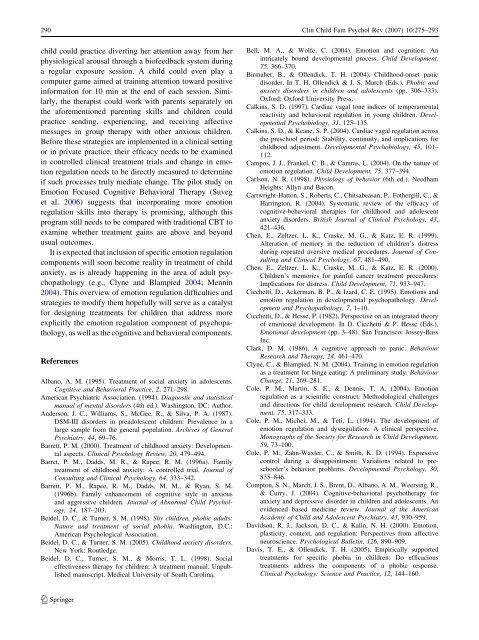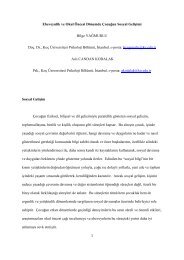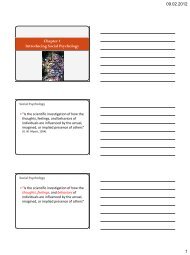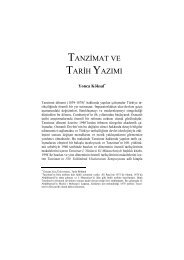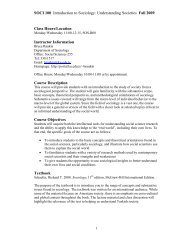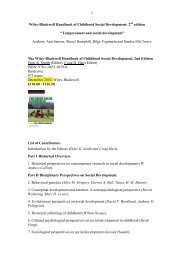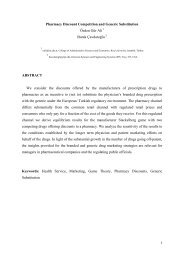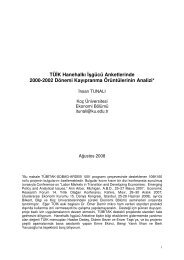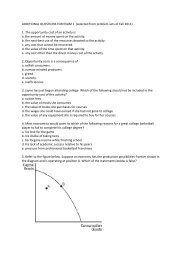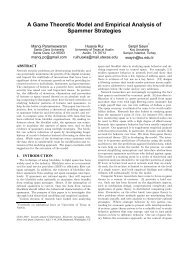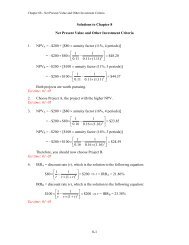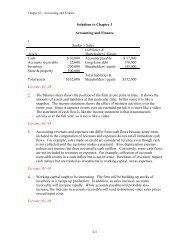The Role of Emotion Regulation in the Treatment of Child Anxiety ...
The Role of Emotion Regulation in the Treatment of Child Anxiety ...
The Role of Emotion Regulation in the Treatment of Child Anxiety ...
You also want an ePaper? Increase the reach of your titles
YUMPU automatically turns print PDFs into web optimized ePapers that Google loves.
290 Cl<strong>in</strong> <strong>Child</strong> Fam Psychol Rev (2007) 10:275–293<br />
child could practice divert<strong>in</strong>g her attention away from her<br />
physiological arousal through a bi<strong>of</strong>eedback system dur<strong>in</strong>g<br />
a regular exposure session. A child could even play a<br />
computer game aimed at tra<strong>in</strong><strong>in</strong>g attention toward positive<br />
<strong>in</strong>formation for 10 m<strong>in</strong> at <strong>the</strong> end <strong>of</strong> each session. Similarly,<br />
<strong>the</strong> <strong>the</strong>rapist could work with parents separately on<br />
<strong>the</strong> aforementioned parent<strong>in</strong>g skills and children could<br />
practice send<strong>in</strong>g, experienc<strong>in</strong>g, and receiv<strong>in</strong>g affective<br />
messages <strong>in</strong> group <strong>the</strong>rapy with o<strong>the</strong>r anxious children.<br />
Before <strong>the</strong>se strategies are implemented <strong>in</strong> a cl<strong>in</strong>ical sett<strong>in</strong>g<br />
or <strong>in</strong> private practice, <strong>the</strong>ir efficacy needs to be exam<strong>in</strong>ed<br />
<strong>in</strong> controlled cl<strong>in</strong>ical treatment trials and change <strong>in</strong> emotion<br />
regulation needs to be directly measured to determ<strong>in</strong>e<br />
if such processes truly mediate change. <strong>The</strong> pilot study on<br />
<strong>Emotion</strong> Focused Cognitive Behavioral <strong>The</strong>rapy (Suveg<br />
et al. 2006) suggests that <strong>in</strong>corporat<strong>in</strong>g more emotion<br />
regulation skills <strong>in</strong>to <strong>the</strong>rapy is promis<strong>in</strong>g, although this<br />
program still needs to be compared with traditional CBT to<br />
exam<strong>in</strong>e whe<strong>the</strong>r treatment ga<strong>in</strong>s are above and beyond<br />
usual outcomes.<br />
It is expected that <strong>in</strong>clusion <strong>of</strong> specific emotion regulation<br />
components will soon become reality <strong>in</strong> treatment <strong>of</strong> child<br />
anxiety, as is already happen<strong>in</strong>g <strong>in</strong> <strong>the</strong> area <strong>of</strong> adult psychopathology<br />
(e.g., Clyne and Blampied 2004; Menn<strong>in</strong><br />
2004). This overview <strong>of</strong> emotion regulation difficulties and<br />
strategies to modify <strong>the</strong>m hopefully will serve as a catalyst<br />
for design<strong>in</strong>g treatments for children that address more<br />
explicitly <strong>the</strong> emotion regulation component <strong>of</strong> psychopathology,<br />
as well as <strong>the</strong> cognitive and behavioral components.<br />
References<br />
Albano, A. M. (1995). <strong>Treatment</strong> <strong>of</strong> social anxiety <strong>in</strong> adolescents.<br />
Cognitive and Behavioral Practice, 2, 271–298.<br />
American Psychiatric Association. (1994). Diagnostic and statistical<br />
manual <strong>of</strong> mental disorders (4th ed.). Wash<strong>in</strong>gton, DC: Author.<br />
Anderson, J. C., Williams, S., McGee, R., & Silva, P. A. (1987).<br />
DSM-III disorders <strong>in</strong> preadolescent children: Prevalence <strong>in</strong> a<br />
large sample from <strong>the</strong> general population. Archives <strong>of</strong> General<br />
Psychiatry, 44, 69–76.<br />
Barrett, P. M. (2000). <strong>Treatment</strong> <strong>of</strong> childhood anxiety: Developmental<br />
aspects. Cl<strong>in</strong>ical Psychology Review, 20, 479–494.<br />
Barret, P. M., Dadds, M. R., & Rapee, R. M. (1996a). Family<br />
treatment <strong>of</strong> childhood anxiety: A controlled trial. Journal <strong>of</strong><br />
Consult<strong>in</strong>g and Cl<strong>in</strong>ical Psychology, 64, 333–342.<br />
Barrett, P. M., Rapee, R. M., Dadds, M. M., & Ryan, S. M.<br />
(1996b). Family enhancement <strong>of</strong> cognitive style <strong>in</strong> anxious<br />
and aggressive children. Journal <strong>of</strong> Abnormal <strong>Child</strong> Psychology,<br />
24, 187–203.<br />
Beidel, D. C., & Turner, S. M. (1998). Shy children, phobic adults:<br />
Nature and treatment <strong>of</strong> social phobia. Wash<strong>in</strong>gton, D.C.:<br />
American Psychological Association.<br />
Beidel, D. C., & Turner, S. M. (2005). <strong>Child</strong>hood anxiety disorders.<br />
New York: Routledge.<br />
Beidel, D. C., Turner, S. M., & Morris, T. L. (1998). Social<br />
effectiveness <strong>the</strong>rapy for children: A treatment manual. Unpublished<br />
manuscript. Medical University <strong>of</strong> South Carol<strong>in</strong>a.<br />
Bell, M. A., & Wolfe, C. (2004). <strong>Emotion</strong> and cognition: An<br />
<strong>in</strong>tricately bound developmental process. <strong>Child</strong> Development,<br />
75, 366–370.<br />
Birmaher, B., & Ollendick, T. H. (2004). <strong>Child</strong>hood-onset panic<br />
disorder. In T. H. Ollendick & J. S. March (Eds.), Phobic and<br />
anxiety disorders <strong>in</strong> children and adolescents (pp. 306–333).<br />
Oxford: Oxford University Press.<br />
Calk<strong>in</strong>s, S. D. (1997). Cardiac vagal tone <strong>in</strong>dices <strong>of</strong> temperamental<br />
reactivity and behavioral regulation <strong>in</strong> young children. Developmental<br />
Psychobiology, 31, 125–135.<br />
Calk<strong>in</strong>s, S. D., & Keane, S. P. (2004). Cardiac vagal regulation across<br />
<strong>the</strong> preschool period: Stability, cont<strong>in</strong>uity, and implications for<br />
childhood adjustment. Developmental Psychobiology, 45, 101–<br />
112.<br />
Campos, J. J., Frankel, C. B., & Camras, L. (2004). On <strong>the</strong> nature <strong>of</strong><br />
emotion regulation. <strong>Child</strong> Development, 75, 377–394.<br />
Carlson, N. R. (1998). Physiology <strong>of</strong> behavior (6th ed.). Needham<br />
Heights: Allyn and Bacon.<br />
Cartwright-Hatton, S., Roberts, C., Chitsabeasan, P., Fo<strong>the</strong>rgill, C., &<br />
Harr<strong>in</strong>gton, R. (2004). Systematic review <strong>of</strong> <strong>the</strong> efficacy <strong>of</strong><br />
cognitive-behavioral <strong>the</strong>rapies for childhood and adolescent<br />
anxiety disorders. British Journal <strong>of</strong> Cl<strong>in</strong>ical Psychology, 43,<br />
421–436.<br />
Chen, E., Zeltzer, L. K., Craske, M. G., & Katz, E. R. (1999).<br />
Alteration <strong>of</strong> memory <strong>in</strong> <strong>the</strong> reduction <strong>of</strong> children’s distress<br />
dur<strong>in</strong>g repeated aversive medical procedures. Journal <strong>of</strong> Consult<strong>in</strong>g<br />
and Cl<strong>in</strong>ical Psychology, 67, 481–490.<br />
Chen, E., Zeltzer, L. K., Craske, M. G., & Katz, E. R. (2000).<br />
<strong>Child</strong>ren’s memories for pa<strong>in</strong>ful cancer treatment procedures:<br />
Implications for distress. <strong>Child</strong> Development, 71, 933–947.<br />
Cicchetti, D., Ackerman, B. P., & Izard, C. E. (1995). <strong>Emotion</strong>s and<br />
emotion regulation <strong>in</strong> developmental psychopathology. Development<br />
and Psychopathology, 7, 1–10.<br />
Cicchetti, D., & Hesse, P. (1982). Perspective on an <strong>in</strong>tegrated <strong>the</strong>ory<br />
<strong>of</strong> emotional development. In D. Cicchetti & P. Hesse (Eds.),<br />
<strong>Emotion</strong>al development (pp. 3–48). San Francisco: Jossey-Bass<br />
Inc.<br />
Clark, D. M. (1986). A cognitive approach to panic. Behaviour<br />
Research and <strong>The</strong>rapy, 24, 461–470.<br />
Clyne, C., & Blampied, N. M. (2004). Tra<strong>in</strong><strong>in</strong>g <strong>in</strong> emotion regulation<br />
as a treatment for b<strong>in</strong>ge eat<strong>in</strong>g: A prelim<strong>in</strong>ary study. Behaviour<br />
Change, 21, 269–281.<br />
Cole, P. M., Mart<strong>in</strong>, S. E., & Dennis, T. A. (2004). <strong>Emotion</strong><br />
regulation as a scientific construct: Methodological challenges<br />
and directions for child development research. <strong>Child</strong> Development,<br />
75, 317–333.<br />
Cole, P. M., Michel, M., & Teti, L. (1994). <strong>The</strong> development <strong>of</strong><br />
emotion regulation and dysregulation: A cl<strong>in</strong>ical perspective.<br />
Monographs <strong>of</strong> <strong>the</strong> Society for Research <strong>in</strong> <strong>Child</strong> Development,<br />
59, 73–100.<br />
Cole, P. M., Zahn-Waxler, C., & Smith, K. D. (1994). Expressive<br />
control dur<strong>in</strong>g a disappo<strong>in</strong>tment: Variations related to preschooler’s<br />
behavior problems. Developmental Psychology, 30,<br />
835–846.<br />
Compton, S. N., March, J. S., Brent, D., Albano, A. M., Weers<strong>in</strong>g, R.,<br />
& Curry, J. (2004). Cognitive-behavioral psycho<strong>the</strong>rapy for<br />
anxiety and depressive disorder <strong>in</strong> children and adolescents. An<br />
evidenced based medic<strong>in</strong>e review. Journal <strong>of</strong> <strong>the</strong> American<br />
Academy <strong>of</strong> <strong>Child</strong> and Adolescent Psychiatry, 43, 930–959.<br />
Davidson, R. J., Jackson, D. C., & Kal<strong>in</strong>, N. H. (2000). <strong>Emotion</strong>,<br />
plasticity, context, and regulation: Perspectives from affective<br />
neuroscience. Psychological Bullet<strong>in</strong>, 126, 890–909.<br />
Davis, T. E., & Ollendick, T. H. (2005). Empirically supported<br />
treatments for specific phobia <strong>in</strong> children: Do efficacious<br />
treatments address <strong>the</strong> components <strong>of</strong> a phobic response.<br />
Cl<strong>in</strong>ical Psychology: Science and Practice, 12, 144–160.<br />
123


